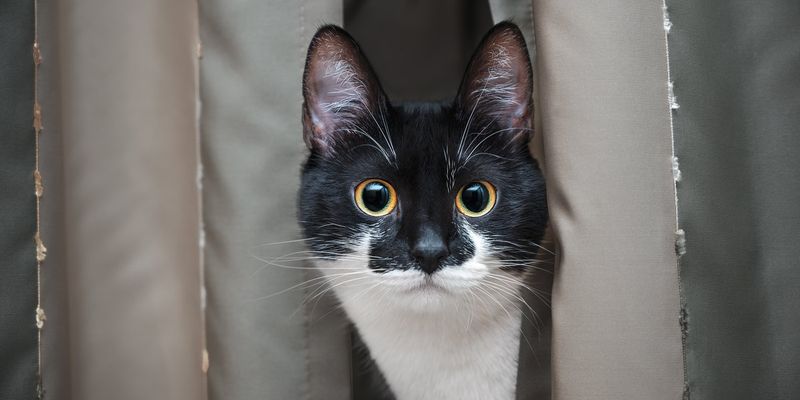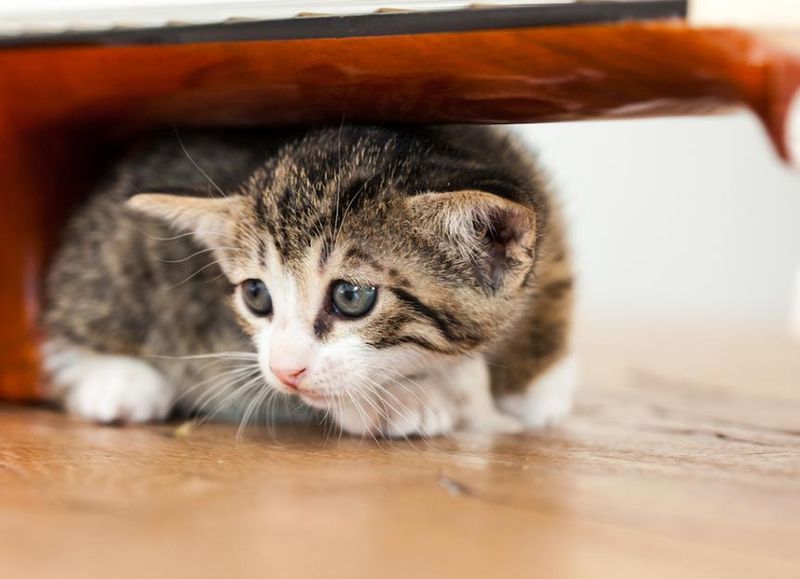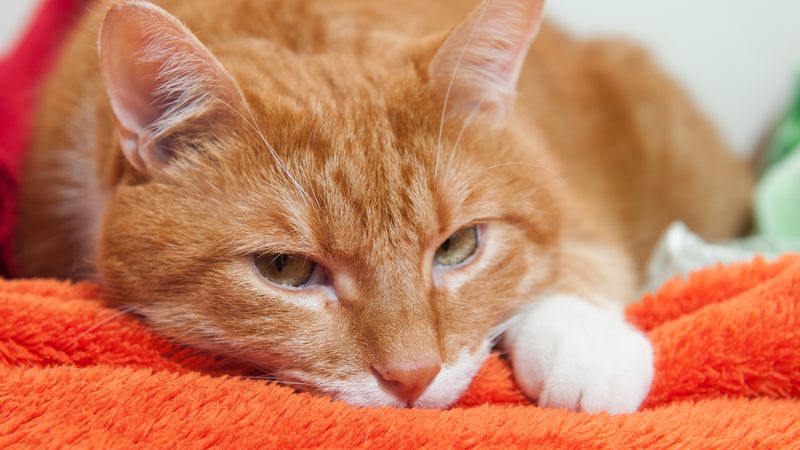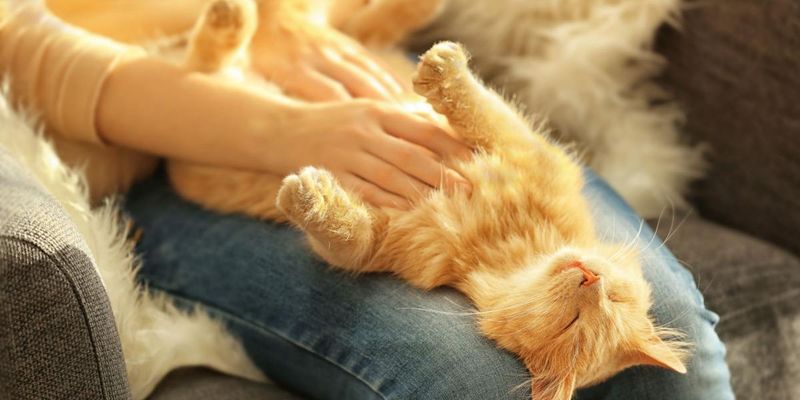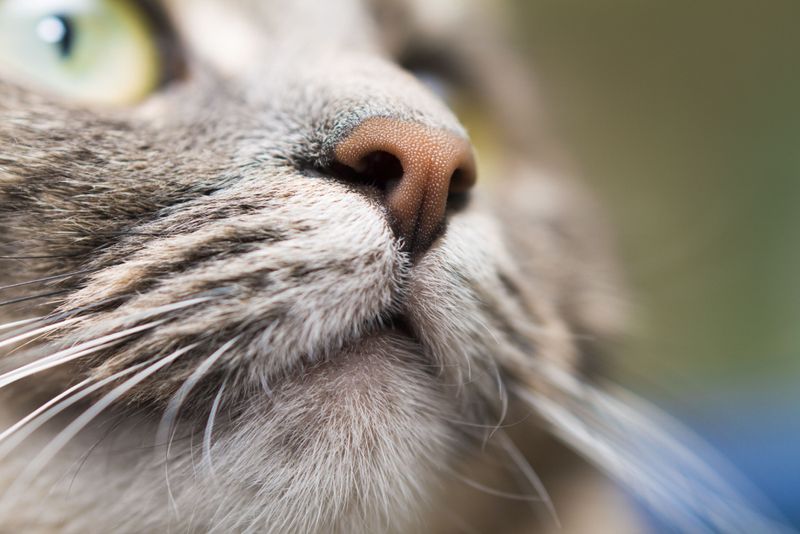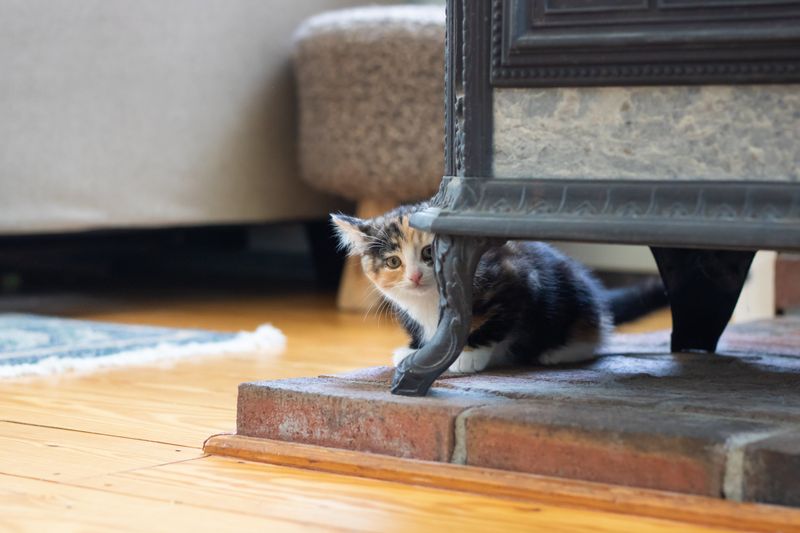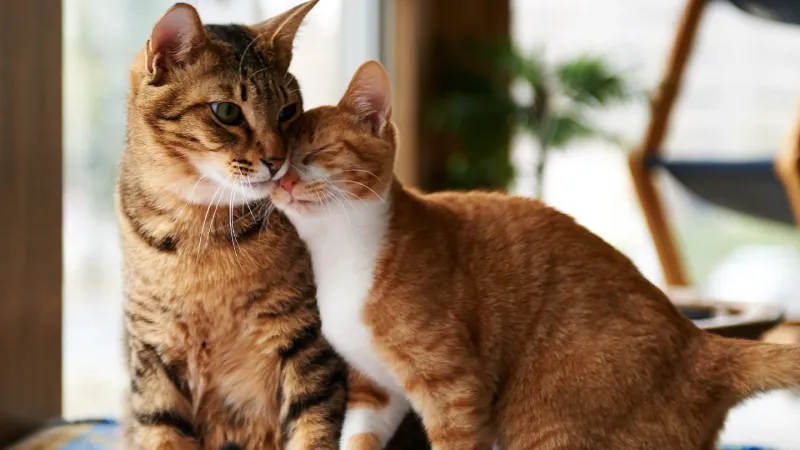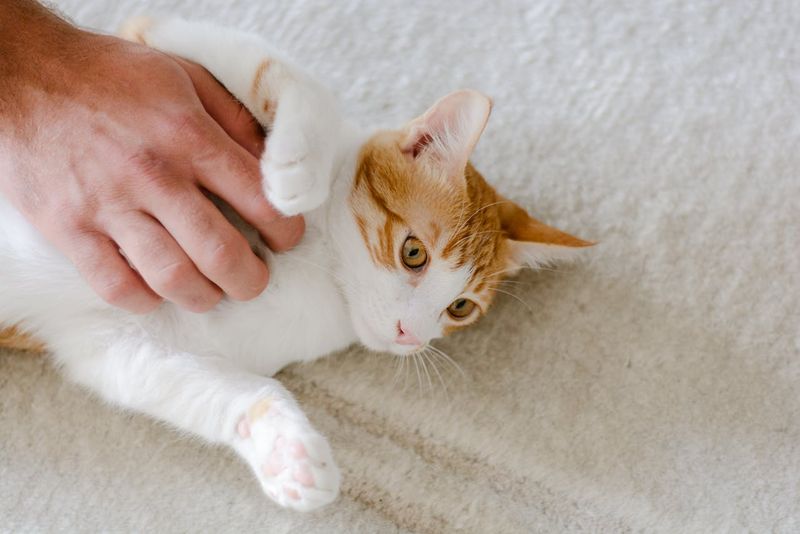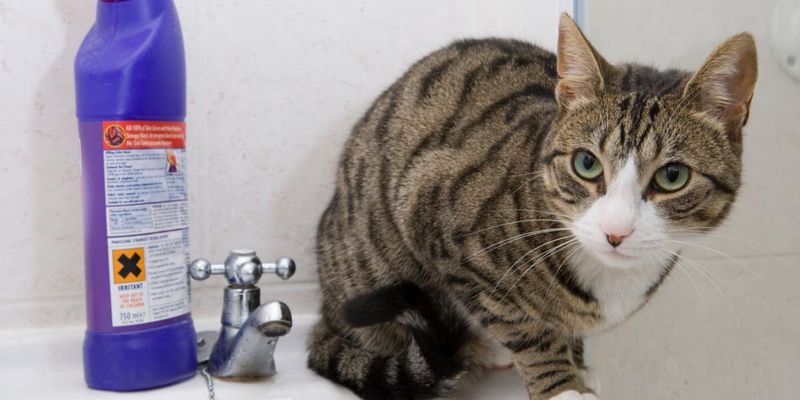📖 Table of Content:
- 1. Direct Eye Contact
- 2. Loud Music or Sudden Noises
- 3. Towering Over Them
- 4. Unexpected Belly Rubs
- 5. Bringing Home New Scents
- 6. Moving Furniture Without Warning
- 7. Forcing Medication or Grooming
- 8. Pointing Fingers or Objects
- 9. Wearing Strong Perfumes or Colognes
- 10. Introducing New Pets Without Transition
- 11. Aggressive Petting or Handling
- 12. Cleaning Products With Strong Scents
- 13. Ignoring Their Warning Signals
- 14. Punishing Natural Behaviors
Cats are mysterious creatures with a complex view of the world around them. Your feline friend might be reacting to your everyday behaviors in ways you never expected. What seems normal and friendly to you could actually be triggering your cat’s defense mechanisms. Understanding these surprising triggers can help strengthen your bond and create a more harmonious home for both of you.
1. Direct Eye Contact
Staring directly at your cat might seem like an act of love, but in the feline world, it’s often interpreted as aggression or a challenge. Cats communicate largely through body language, and sustained eye contact is how predators lock onto prey.
Next time you want to show affection, try slow blinking instead. This action, sometimes called a ‘cat kiss,’ signals trust and relaxation. Your furry friend will appreciate this gesture much more than an intense stare-down.
Many cat owners notice their pets gravitate toward people who actually ignore them—these humans aren’t sending threatening signals!
2. Loud Music or Sudden Noises
Cranking up your favorite tunes might be your idea of a good time, but your cat’s sensitive ears perceive loud sounds as potential danger. Their hearing range far exceeds human capabilities, making even moderate volumes potentially uncomfortable.
Cats rely on their acute hearing to detect predators and prey in the wild. Sudden loud noises trigger their fight-or-flight response, causing unnecessary stress and anxiety.
Gradual volume increases and creating a quiet sanctuary where your cat can retreat helps them feel secure. Remember that even everyday household noises like blenders or vacuum cleaners can be terrifying from your cat’s perspective.
3. Towering Over Them
Standing tall might be your natural posture, but to your smaller feline companion, your height can seem intimidating. When you loom over your cat, especially in enclosed spaces, you’re unknowingly mimicking predator behavior.
Cats feel most vulnerable when approached from above. Their wild ancestors learned to watch the skies for aerial predators, and this instinct remains strong in domestic cats.
Getting down to your cat’s level before interacting creates a more equal playing field. Crouching, sitting, or kneeling makes you appear less threatening and shows respect for your cat’s personal space. This simple adjustment can transform tense interactions into pleasant ones.
4. Unexpected Belly Rubs
Your cat’s fluffy exposed belly might look like an invitation for cuddles, but reaching for it often triggers defensive reactions. When cats roll over, they’re usually showing trust, not requesting a tummy rub.
The belly is one of the most vulnerable areas on a cat’s body. In the wild, protecting vital organs is crucial for survival, and this instinct remains strong in domestic cats.
Respect your cat’s boundaries by focusing on safer petting zones like the head, cheeks, and back. Some cats do enjoy gentle belly contact after building trust, but always let your cat initiate and guide these interactions. Watch for subtle signals that indicate your pet’s comfort level has changed.
5. Bringing Home New Scents
Returning home with unfamiliar smells clinging to your clothes can trigger suspicion in your territorial cat. Cats rely heavily on scent for identification and security, making foreign odors particularly unsettling.
Your feline friend might sniff you cautiously or even hiss after you’ve visited a friend with pets or spent time in scent-heavy environments like hospitals or pet stores. These reactions aren’t personal—they’re protective responses to potential threats to their territory.
Allow your cat to investigate new scents at their own pace. Changing clothes after significant exposure to other animals can help reduce tension and maintain your status as a trusted family member rather than a stranger carrying invader scents.
6. Moving Furniture Without Warning
Rearranging your living room might freshen your space, but it creates chaos in your cat’s carefully mapped mental territory. Cats develop detailed mental maps of their environments and rely on consistency for security.
When furniture suddenly shifts position, your cat loses established pathways, hiding spots, and scent-marked territories. This disruption can trigger stress and defensive behaviors as they navigate what feels like an entirely new and potentially dangerous environment.
Gradual changes and maintaining some familiar elements helps cats adapt more comfortably. Providing extra attention, treats, and play during transition periods reassures your cat that despite the changes, they remain safe and valued in their territory.
7. Forcing Medication or Grooming
Administering medicine or tackling matted fur might be necessary for your cat’s health, but restraining them feels like a predator’s grip. Cats instinctively fight against any form of forced handling, especially when it involves uncomfortable sensations.
Your good intentions get lost in translation during these encounters. From your cat’s perspective, being held down while something unpleasant happens feels like a life-threatening situation, not healthcare.
Building positive associations through gentle handling sessions, treats, and patience helps reduce stress during necessary procedures. Using proper techniques like wrapping nervous cats in a towel can increase safety for both of you while minimizing the feeling of being trapped.
8. Pointing Fingers or Objects
Pointing directly at your cat might seem harmless, but to them, it resembles a striking paw or predator movement. Extended fingers or objects moving toward their face trigger defensive reactions based on self-preservation instincts.
Cats often swat at pointing fingers, not out of playfulness but as a warning to back away from their personal space. This reaction is especially common in cats with previous negative experiences involving hands.
Approaching cats with an open palm or the back of your hand at their eye level creates a less threatening introduction. This posture allows them to investigate your scent and intentions before physical contact occurs, building trust through respect for their boundaries.
9. Wearing Strong Perfumes or Colognes
Dousing yourself in fragrance might please your human friends but overwhelms your cat’s sensitive olfactory system. Cats have approximately 200 million odor receptors compared to our mere 5 million, making strong scents genuinely uncomfortable.
Artificial fragrances can mask the familiar scents cats use to identify you as their trusted companion. This scent confusion sometimes leads to cats treating their owners like strangers or potential threats.
Opting for unscented products or applying fragrances sparingly creates a more comfortable environment for your feline friend. Many cats show greater affection toward their humans after shower time, when natural scents become more prominent and artificial ones wash away.
10. Introducing New Pets Without Transition
Bringing home a new furry family member without proper introduction protocols signals danger to your resident cat. Territorial by nature, cats perceive unexpected animal visitors as invaders threatening their resources and safety.
The sudden appearance of another pet disrupts the established social order and scent profile of your home. Your cat’s aggressive or fearful response isn’t jealousy—it’s a legitimate survival strategy.
Gradual introductions through scent exchange, separate spaces, and supervised interactions build tolerance over time. Respecting your existing cat’s need for territory and maintaining their routines during transition periods demonstrates that the newcomer doesn’t threaten their security or your bond.
11. Aggressive Petting or Handling
Enthusiastic petting sessions might satisfy your need for connection, but rough handling triggers your cat’s defense mechanisms. Cats prefer gentle, predictable touches in specific areas rather than vigorous full-body contact.
Overstimulation during petting creates a conflicting experience—starting pleasantly but becoming uncomfortable or even painful. Your cat’s sudden biting or scratching isn’t random aggression but a clear communication that their tolerance threshold has been crossed.
Learning to recognize subtle warning signs like tail twitching, skin rippling, or ear position changes helps prevent negative interactions. Short, positive petting sessions that end before your cat shows discomfort build trust and teach them that their boundaries will be respected.
12. Cleaning Products With Strong Scents
Household cleaning products leave behind chemical scents that overwhelm your cat’s sensitive nose and mask important territorial markers. The artificial fragrances in these products can seem like intrusive, unfamiliar elements in what should be a comfortable space.
Cats rely on scent marking to create a sense of security in their environment. When strong cleaning chemicals override these familiar smells, cats may feel disoriented or anxious, as if they’re suddenly in unfamiliar territory.
Using pet-safe, unscented cleaning alternatives preserves your cat’s scent landscape while maintaining cleanliness. Focusing cleaning efforts on specific problem areas rather than entire spaces helps maintain some familiar scents that provide comfort and territorial reassurance.
13. Ignoring Their Warning Signals
Cats communicate discomfort through subtle body language long before resorting to hissing or scratching. Flattened ears, dilated pupils, and tail positioning are sophisticated warning systems designed to prevent conflict.
Continuing to interact with a cat showing these signals teaches them their communication isn’t effective. When early warnings go unheeded, cats learn to skip straight to more aggressive responses that humans can’t ignore.
Respecting these communication attempts builds trust and security. Giving your cat space when they request it through body language strengthens your relationship by demonstrating respect for their autonomy. Most cat aggression toward owners results from repeatedly ignored warnings rather than unpredictable behavior.
14. Punishing Natural Behaviors
Scolding your cat for scratching furniture or jumping on counters creates confusion and fear rather than better behavior. These actions are natural feline behaviors necessary for physical and mental wellbeing, not deliberate disobedience.
Cats don’t connect punishment with their actions the way humans expect. Instead, they learn to fear the punisher rather than modify the behavior. This fear damages your bond and increases stress-related problems.
Providing appropriate alternatives like scratching posts, climbing trees, and interactive toys redirects natural behaviors to acceptable outlets. Positive reinforcement when your cat uses these alternatives creates lasting behavior change through trust rather than fear, preserving your relationship while protecting your belongings.

